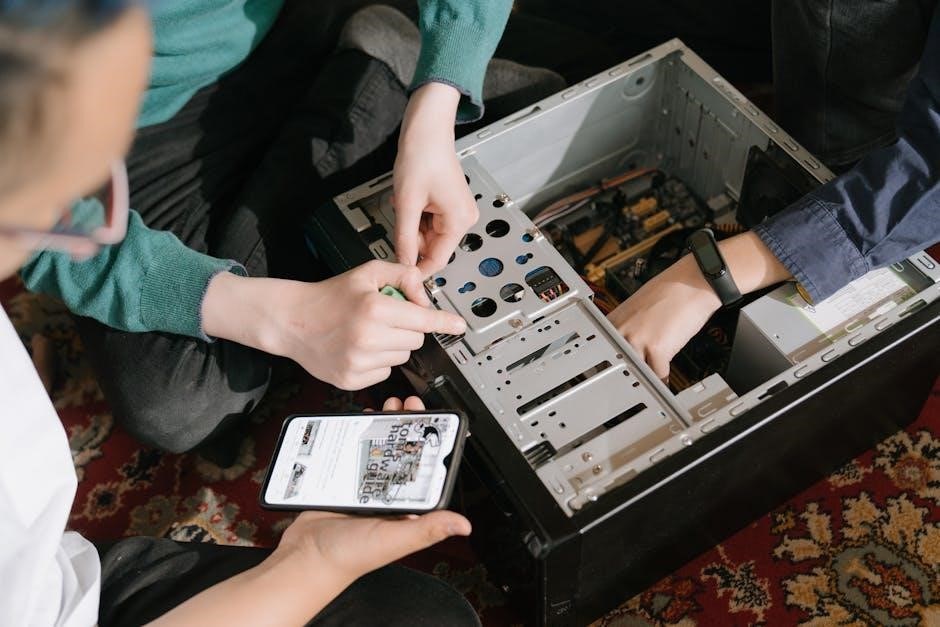bikeberry.com install guide
Motorized bicycles combine cycling with engine power‚ offering eco-friendly transportation; They feature 2-stroke or 4-stroke engines‚ providing a cost-effective‚ fun way to commute or explore.
1.1 What Are Motorized Bicycles?
Motorized bicycles are traditional bikes equipped with engine kits‚ such as 2-stroke or 4-stroke engines‚ or electric motors. They combine pedal power with engine assistance‚ offering a versatile and eco-friendly transportation option. These bikes are popular for commuting and recreational rides‚ providing a cost-effective alternative to cars. The installation of engine or electric kits‚ as detailed in guides like those from BikeBerry‚ allows users to customize their bikes for performance and efficiency‚ making motorized bicycles a practical choice for various terrains and preferences.
1.2 Benefits of Using Motorized Bicycles
Motorized bicycles offer a convenient‚ eco-friendly‚ and cost-effective way to travel. They reduce reliance on fossil fuels and lower emissions‚ making them an environmentally conscious choice. These bikes are ideal for commuting‚ offering a smoother ride over long distances compared to traditional cycling. With options like 2-stroke and 4-stroke engine kits or electric motors‚ users can customize performance to suit their needs. The installation guides from BikeBerry simplify the process‚ making motorized bicycles accessible for riders seeking a practical yet enjoyable transportation solution.

Choosing the Right Engine Kit for Your Bike
Selecting the right engine kit involves considering factors like bike frame compatibility‚ power needs‚ and installation ease. Options include 2-stroke‚ 4-stroke‚ or electric kits.
2.1 Types of Engine Kits Available
Engine kits for motorized bicycles include 2-stroke‚ 4-stroke‚ and electric options. 2-stroke kits are lightweight‚ compact‚ and offer high power for their size. 4-stroke kits provide better fuel efficiency and lower emissions but are heavier. Electric kits are eco-friendly‚ quiet‚ and require minimal maintenance. Each type caters to different needs‚ such as speed‚ range‚ and environmental impact. Choosing the right kit depends on your riding style‚ terrain‚ and local regulations.
2.2 Factors to Consider When Selecting an Engine Kit
When selecting an engine kit‚ consider power output‚ weight‚ and compatibility with your bike. Choose a kit that suits your riding style‚ terrain‚ and load capacity. Fuel efficiency‚ emissions‚ and noise levels are important for practicality. Budget‚ brand reputation‚ and warranty should also influence your decision. Ensure the kit meets local regulations for legal compliance. Proper fitment and installation requirements are crucial for safety and performance. Always check reviews and specifications to match your needs effectively.

Pre-Installation Checks and Preparation
Ensure compatibility‚ gather tools‚ and prepare workspace. Verify bike specifications‚ safety gear‚ and environmental conditions. Review instructions thoroughly before starting the installation process for optimal results.
3.1 Tools and Materials Needed
To begin the installation‚ gather essential tools and materials. These include wrenches‚ screwdrivers‚ pliers‚ Allen keys‚ and a torque wrench. Additional items like fuel‚ oil‚ and a funnel are necessary for the engine. Ensure you have gloves‚ goggles‚ and a clean workspace. Verify all components of the kit are included and undamaged. Organize tools and materials for easy access‚ and consult the manual for specific requirements. Proper preparation ensures a smooth and efficient installation process for your motorized bicycle kit.
3.2 Safety Precautions
Always wear protective gear‚ including gloves and goggles‚ to prevent injuries; Ensure the workspace is clear of flammable materials and well-ventilated. Disconnect the battery before working on electrical components. Avoid loose clothing that could catch on moving parts. Keep the workspace clean to prevent accidents. Never test the engine near open flames or sparks. Follow the manual’s instructions carefully and ensure the bike is stable before starting. Safety should always be the top priority when working with motorized components and tools.
3.3 Workspace Preparation
Prepare a clean‚ flat‚ and stable workbench or surface for installation. Ensure the area is free from distractions and obstacles. Organize tools and components in a toolbox or on a mat to avoid losing parts. Use a vice or clamps to secure the bike frame during work. Cover the floor with cardboard or a tarp to protect against spills or debris. Ensure good lighting to see small components clearly. Keep all necessary materials within easy reach to streamline the process. A well-prepared workspace enhances efficiency and safety during installation.

Understanding the Components of the Engine Kit
The engine kit includes a cylinder‚ piston‚ crankshaft‚ fuel tank‚ and electrical wiring. It also features a 2-stroke or 4-stroke engine‚ depending on the model. The wiring connects the ignition‚ throttle‚ and spark plug for proper functionality. Understanding these components is crucial for successful installation and troubleshooting. Always refer to the manual for specific part locations and functions. Proper knowledge ensures safe and efficient assembly of the motorized bicycle.
4.1 Overview of the 2-Stroke Engine Kit
A 2-stroke engine kit is a popular choice for motorized bicycles due to its lightweight and high power-to-weight ratio. It includes a cylinder‚ piston‚ and crankshaft‚ operating on a 2-stroke cycle: intake and compression‚ then power and exhaust. The engine requires a fuel-oil mixture for lubrication and is known for its simplicity and easier installation. It offers quick acceleration and is ideal for smaller bikes. However‚ it may have lower fuel efficiency and higher emissions compared to 4-stroke engines. Always consult the manual for specific assembly instructions and recommendations.
4.2 Overview of the 4-Stroke Engine Kit
A 4-stroke engine kit is another popular option for motorized bicycles‚ offering improved fuel efficiency and lower emissions compared to 2-stroke engines. It operates on four cycles: intake‚ compression‚ power‚ and exhaust. The engine includes a cylinder head‚ valves‚ and a camshaft‚ providing smoother operation and better reliability. It is heavier and more complex but ideal for longer rides and higher torque requirements. The engine requires regular oil changes and is generally quieter. This kit is recommended for riders seeking durability and reduced environmental impact.

4.3 Electrical Wiring Components
The electrical wiring components are crucial for powering and controlling the motorized bicycle. The kit typically includes a controller‚ wiring harness‚ throttle‚ ignition switch‚ and battery connectors. The controller regulates power flow from the battery to the motor‚ while the throttle adjusts speed. Proper connections ensure safe and efficient operation. Always follow the wiring diagram provided in the Bikeberry installation guide to avoid short circuits or electrical failures. Using the correct gauge wires and connectors is essential for reliability and performance. Regularly inspect the wiring for wear or damage to maintain optimal functionality and safety;

Step-by-Step Installation Guide
This section provides a detailed‚ step-by-step guide to installing the engine kit on your bicycle. Follow the instructions carefully to ensure proper mounting‚ wiring‚ and testing.
5.1 Mounting the Engine to the Bicycle Frame
Mounting the engine securely is crucial for stability and performance. Ensure the engine kit is compatible with your bike’s frame size and type. Align the engine with the frame’s mounting points‚ typically near the bottom bracket. Use the provided brackets and bolts to fasten the engine firmly. Tighten all connections gradually to avoid misalignment. Double-check the manufacturer’s specifications for torque settings. If unsure‚ consult the Bikeberry installation manual or seek professional assistance to ensure a safe and proper installation.
5.2 Connecting the Electrical Wiring
Connecting the electrical wiring requires careful attention to ensure proper functionality. Start by identifying the key connectors: battery‚ throttle‚ ignition‚ and motor. Follow the wiring diagram provided in the Bikeberry manual. Connect the positive and negative terminals to the battery first. Then‚ link the throttle to the controller and the ignition switch to the engine. Use heat-resistant sleeves for wires near the engine. Test the system by turning the ignition and gently pressing the throttle to ensure smooth operation before finalizing connections.
5.3 Installing the Fuel System
Installing the fuel system involves attaching the fuel tank‚ routing the fuel line‚ and connecting it to the carburetor. Secure the fuel tank to the bike frame using brackets or straps. Route the fuel line from the tank to the carburetor‚ ensuring no kinks or damage. Attach the fuel line connectors tightly to prevent leaks. Use the provided fuel filter to ensure clean fuel flow. Finally‚ connect the fuel line to the carburetor inlet. Bleed the system by gently pressing the primer bulb to remove air bubbles. Test the system by starting the engine and checking for leaks.
5.4 Initial Startup and Testing
After completing the installation‚ locate the bike in a well-ventilated area and ensure all connections are secure. Prime the fuel system by gently pressing the primer bulb 2-3 times. Turn the ignition key and press the start button. Allow the engine to warm up for a few seconds before testing. Check for unusual noises or leaks. Test the throttle response at low and high RPMs. Ensure the engine runs smoothly and idles consistently. If issues arise‚ refer to the troubleshooting section or consult the manual for specific settings and adjustments.

Installing the Electric Bike Kit
This section provides a step-by-step guide to installing an electric bike kit‚ including motor mounting‚ battery connection‚ and controller setup for efficient‚ eco-friendly cycling.
6.1 Overview of the Electric Bike Kit
An electric bike kit typically includes a motor‚ battery‚ controller‚ and throttle; It converts a standard bicycle into a powered vehicle‚ offering eco-friendly transportation. Kits vary in power and range‚ with options for different terrains and riding styles. The motor is usually mounted on the wheel hub or crank‚ while the battery is placed on the frame for balance. These kits provide a cost-effective and sustainable alternative to traditional motorized bikes‚ with minimal installation effort required for functionality.
6.2 Mounting the Electric Motor
Mounting the electric motor involves attaching it to the bicycle’s wheel hub or frame. For a rear-wheel motor‚ remove the existing wheel and replace it with the motorized one. Ensure proper alignment and secure the motor using the provided hardware. Front-wheel motors are typically bolted onto the fork dropouts. Use spacers if needed for a snug fit. Tighten all bolts to the recommended torque specification to prevent vibration loosening. Always refer to the manufacturer’s manual for specific instructions and safety precautions;
6.3 Connecting the Battery and Controller
Connecting the battery and controller requires careful attention to polarity and wiring. Locate the controller near the motor for optimal performance. Attach the battery to the frame using brackets or straps. Connect the positive (red) and negative (black) wires to the controller‚ ensuring proper polarity; Link the motor to the controller using the provided wiring harness. Secure all connections with heat shrink or electrical tape. Disconnect the battery before making any adjustments. Finally‚ test the throttle and brakes to ensure proper functionality. Always refer to the manual for specific wiring diagrams and torque specifications.
6.4 Final Adjustments and Testing
After installing the electric bike kit‚ perform a thorough inspection of all connections. Ensure the motor‚ controller‚ and battery are securely fastened. Test the throttle by gently pressing it to confirm smooth power delivery. Check the brakes for proper function and adjust if necessary. Take the bike for a short‚ safe test ride on a flat surface to verify balanced performance. Monitor for any unusual noises or vibrations. Refer to the manual for troubleshooting common issues and ensure all components are functioning as intended before regular use.

Troubleshooting Common Issues
Identify symptoms like poor performance or electrical faults. Check connections‚ wiring‚ and battery charge. Lubricate moving parts if stuck. Refer to the manual for specific fixes.
7.1 Common Problems During Installation
During installation‚ common issues include misaligned parts‚ loose connections‚ or incorrect wiring. Ensure all components fit properly and connections are secure. Verify wiring matches the diagram. Check for bent or damaged parts. If the engine doesn’t start‚ inspect the fuel flow and spark plug. Consult the manual for torque specifications to avoid stripped threads. Addressing these issues early prevents larger problems down the line.
- Misaligned parts can cause mechanical failure.
- Loose connections may lead to electrical malfunctions.
- Incorrect wiring can result in engine startup issues.
7.2 Solutions for Engine Malfunctions
Addressing engine malfunctions requires identifying the root cause. Check the fuel system for blockages or leaks. Ensure the spark plug is clean and properly gapped. Verify the air filter is clean and the muffler is free of debris. If the engine overheats‚ inspect the cooling system. Adjust the carburetor if necessary. Consult the manual for specific troubleshooting steps. Regular maintenance‚ such as oil changes‚ can prevent many issues. Replacing worn or damaged parts promptly ensures reliable performance.
- Inspect fuel lines and filters for blockages.
- Ensure proper spark plug installation and condition.
- Check cooling systems for optimal function.
7.3 Electrical System Faults and Fixes
Electrical issues can often be resolved by checking connections and components. Loose wires or corroded terminals can disrupt power flow. Use a multimeter to test for continuity and voltage. A blown fuse or tripped circuit breaker may indicate an overload. Replace faulty components like spark plugs or ignition coils. Ensure the battery is fully charged and connections are secure. Properly route wires to avoid damage. Refer to the wiring diagram for troubleshooting specific circuits.
- Inspect wiring for damage or loose connections.
- Test electrical components with a multimeter;
- Ensure the battery is charged and connections are secure.

Post-Installation Checks
After installation‚ inspect all connections‚ test the engine‚ and ensure proper braking function. Verify electrical systems and fuel lines for leaks or damage. Conduct a test ride to confirm smooth operation.
- Check engine performance and electrical connections.
- Inspect brakes for proper functionality.
- Test ride to ensure overall system efficiency.
8.1 Ensuring Proper Engine Function
After installation‚ start the engine and let it idle to check for unusual noises or vibrations. Ensure proper throttle response and smooth acceleration. Inspect for any fuel or oil leaks. Monitor engine temperature during operation to avoid overheating. Perform a test ride to evaluate performance under various conditions‚ ensuring the engine operates consistently and efficiently. Address any issues promptly to maintain reliability and safety.
- Check engine idle and throttle responsiveness.
- Inspect for leaks in fuel and oil systems.
- Monitor temperature during initial operation.
8.2 Verifying Electrical Connections
After installation‚ inspect all electrical connections to ensure they are secure and properly insulated. Use a multimeter to check for continuity and short circuits. Verify that the battery‚ controller‚ and motor are connected correctly. Ensure all wires are tightly fastened and routed away from moving parts. Test the electrical system under load to confirm proper function. Address any loose or faulty connections immediately to prevent malfunctions or electrical hazards.
- Check for secure and insulated connections.
- Test continuity and short circuits with a multimeter.
- Ensure correct wiring between components.
8.3 Testing the Braking System
After installation‚ test the braking system thoroughly to ensure safety and proper function. Start by checking the brake levers for any sponginess or delays. Ride the bike at a moderate speed and apply the brakes firmly to verify consistent stopping power. Test both front and rear brakes separately to ensure balanced performance. Inspect the brake pads and rotors for proper alignment and wear. Address any issues immediately to maintain safe riding conditions.
- Test brakes at moderate speed.
- Check for sponginess or delays.
- Inspect brake pads and rotors.

Maintenance and Upkeep
Regular maintenance ensures optimal performance and longevity of your motorized bike. Clean moving parts‚ check for wear‚ and lubricate components after every ride or monthly.
- Clean and lubricate moving parts.
- Inspect for wear and damage.
- Perform routine checks after rides.
9.1 Regular Maintenance Schedule
A well-planned maintenance schedule ensures your motorized bike runs smoothly. Daily checks include inspecting tire pressure and chain tension. Weekly‚ clean the chain and lubricate moving parts. Monthly‚ check brake pads‚ inspect electrical connections‚ and ensure proper engine oil levels. Every 500 miles‚ replace the air filter and spark plug. Annually‚ inspect and replace high-mileage components like piston rings or spark plugs. Regular lubrication of gears and joints prevents wear. Following this schedule enhances performance‚ safety‚ and extends the lifespan of your motorized bicycle.
9.2 Tips for Extending Engine Life
To maximize engine longevity‚ use high-quality fuel and avoid over-revving. Ensure proper engine cooling by maintaining adequate airflow. Regularly inspect and clean the air filter to prevent dust buildup. Avoid extreme loads or towing heavy weights. Store the bike in a dry‚ shaded area during extended periods of inactivity. Change engine oil every 500 miles and replace spark plugs as recommended. Properly sync the carburetor and avoid overheating. Following these tips ensures optimal performance and extends the lifespan of your motorized bicycle’s engine.
9.3 Cleaning and Lubricating Moving Parts
Regularly clean and lubricate all moving parts to ensure smooth operation and prevent wear. Use a soft brush to remove dirt and grime from chains‚ gears‚ and pivot points. Apply a high-quality silicone-based lubricant to moving components‚ avoiding over-lubrication. Clean the chain with a mild detergent and water mixture before re-lubricating. Inspect cables and hinges for friction and apply grease as needed. This maintenance routine reduces friction‚ prevents corrosion‚ and extends the lifespan of your motorized bicycle’s mechanical components.
Completing the installation guide successfully enhances your motorized bicycle’s performance. Follow all steps carefully and always prioritize safety while riding your newly upgraded bike.
10.1 Summary of the Installation Process
The Bikeberry.com install guide provides a detailed‚ step-by-step approach to transforming a standard bicycle into a motorized one. From choosing the right engine kit to final testing‚ it ensures a smooth transition. The guide emphasizes safety precautions‚ workspace preparation‚ and proper tool usage. By following each section meticulously‚ even novice users can achieve professional results. The comprehensive instructions cover engine mounting‚ wiring connections‚ and fuel system installation‚ making the process accessible and manageable for all skill levels. This thorough guide guarantees a successful upgrade.
10.2 Final Tips for Safe Riding
Always wear protective gear‚ including a helmet‚ gloves‚ and reflective clothing. Familiarize yourself with local traffic laws and ride responsibly. Ensure your bike is well-maintained‚ with functioning brakes and proper tire pressure. Stay alert and avoid distractions while riding. Use lights and reflectors to increase visibility‚ especially at night. Respect pedestrians and other cyclists‚ and never ride under the influence of alcohol or drugs. Following these guidelines will enhance your safety and enjoyment on the road.
